Louann’s – Part 4
Story by Chelle Bovis Banks
Be sure to check out Part 1, Part 2 and Part 3 if you haven’t already!
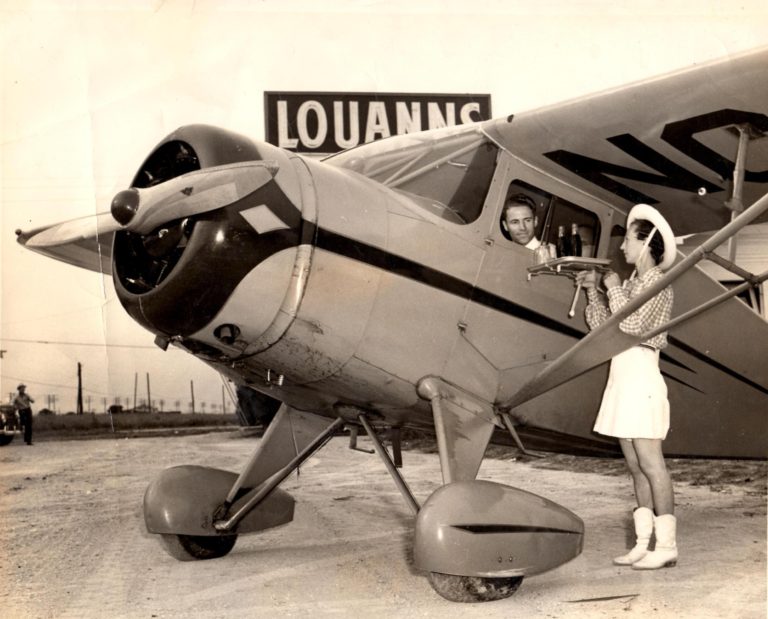
When they said ‘curb service’ at Louann’s, they meant it!
The Lives And Times Of Lou and Ann Bovis
‘Creating a Dallas Landmark’
By Chelle Bovis Banks
Edited by Paul Heckmann, Executive Director Memories Incorporated
In loving memory of
Louis William Bovis (1893–1950)
Ann T. Bovis (1910-1993)
Philip Charles Bovis (1947-1994)
Joseph Bovis (1948)
And dedicated with love to
Louis W. Bovis II (1951-2007)
Forward
It is somewhat odd to learn more about your parents after their deaths than while they are living, but that is exactly what happened in my case. Indeed, the first inkling of just how exceptional they were occurred at my mother’s 80th birthday party where guests were invited to bring Louann’s memorabilia in lieu of gifts, and a 1947 Newsweek magazine was among the cache. The article inside provided a surprising insight into how multi-dimensional Lou and Ann Bovis were. I say “surprising” because I had no prior knowledge of that article, and it turned out to be just one of many discoveries ahead.
Shortly after the death of my mother in 1993, I uncovered a treasure trove of old photos, newspapers, and magazines from the closets and files at her ranch. There were also deeds, contracts, wills, journals, adoption papers, 16mm family movies, scrapbooks, menus, greeting and post cards. Old letters were nestled inside the books of her vast library. Most of it I had never seen before. As I struggled with grief over my mother’s death, each old piece of my parents’ past brought fresh tears along with new respect and admiration.

Lou and Ann Bovis on their wedding day at Louann’s
For many years I have wanted to document the lives of the two remarkable people to whom that over-75-years of history belongs. It would be a shame if it were lost forever. Still, I did not know where to begin or even who could help identify so much of what I found. After all, most of my memories as a child were simple ones: roller skating or bicycle riding in the outdoor garden at the club, searching under the tables for pocket change or bills lost by patrons the evening before, playing Bingo on Shriner’s night, or watching all the beautiful people dancing. Even though friends and relatives have often encouraged me to write a book about the couple, it was only after much research that I could put enough of the pieces together to do them justice.
So, now it is with great pride that I share with you a portion of the lives and times of Lou and Ann Bovis as pertains to their landmark night club and other of their lesser known, yet note-worthy, accomplishments during the years it was in existence. This is far from their whole story, but then that really would take a book. For those of you who are former Louann’s patrons, I hope you enjoy this trip down memory lane and that it rekindles your own, more personal memories of this wonderful part of Dallas history.
It is rather difficult to describe what was so special about Louann’s. Perhaps you just had to be there. Dallas certainly had plenty of drive-ins, restaurants, and night clubs; so what was so unique about this one that it flourished for three decades in the same location and under the same ownership and management while so many others faded away? Whether it was an annual convention of “little people,” a company Christmas party, a politician’s victory bash, a wedding reception, or just the usual crowd – what it came down to was that Louann’s was affordable, was easily accessible from anywhere in Dallas, had plenty of parking, served delicious food, and had lots of room to dance indoors and out. Further, it had the customer support to afford the biggest names in musical entertainment. It was a simple formula that added up to good, clean fun for everyone. And behind it all were its two charismatic owners who cared about the wants and needs of their customers, were flexible to changing times, and who gave back generously to their community.
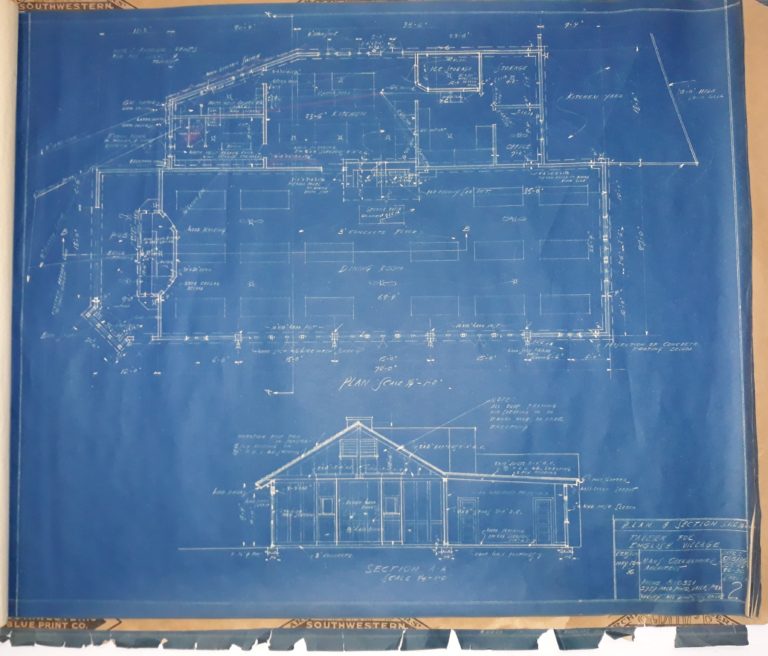
Original, pre-Texas Centenial blueprints for Lou and Ann Bovis’ English Village, Falstaff Tavern
What brought Lou and Ann Bovis to Dallas, as it did many others, was the 1936 Texas Centennial on the Fair Grounds where they operated the English Village outdoor dance spot and Falstaff Tavern restaurant and lived in a small apartment above their business. Both were avid golfers and Ann frequently found time to play a round with her friend Babe Didrikson, the 1932 Olympian who had taken up golf in 1935 and who later helped organize the Ladies Professional Golf Association (LPGA). Ann and Lou stayed on through the Pan-American Exposition in 1938 and 1939; and as it wound down, they began looking for land on which to build a permanent place.
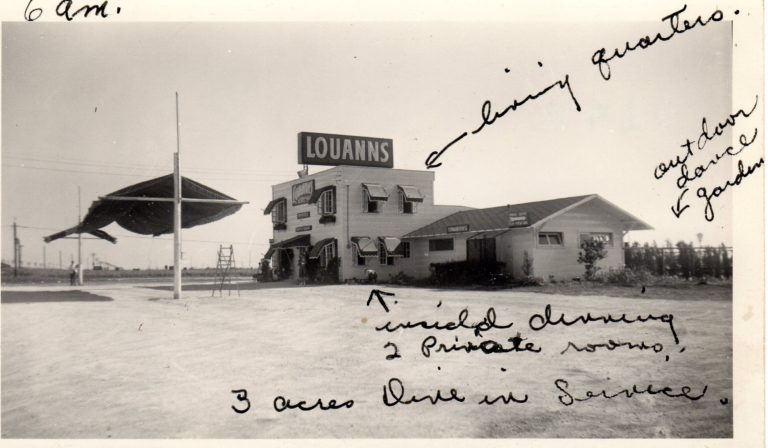
The original drive-in that began life as a soda pop stand, circa 1939
In 1939, they leased a little more than five acres at the southeast corner of Greenville Avenue and Lovers Lane which was then considered very far, north Dallas. (In 1946 they purchased the 5+ acres from the Caruths for $3000.00 per acre.) They moved all the lumber they could salvage from their former business at the Fair Grounds and began constructing Louann’s which was originally considered a drive-in.
The building faced Greenville Avenue, with a large area between the front doors and the street for the customers to park. Colored awnings provided shade, and waitresses dressed like cowgirls served patrons right at their cars (or occasionally, their planes!). Drive-ins were very popular at the time, with a new one opening monthly or even weekly somewhere in the Dallas–Fort Worth area. The ladies who served drive-in customers were called “hop girls” and their costumes (usually abbreviated) were a big draw. The Dallas Journal referred to them as “glamburger gals” and observed that customers of drive-ins had increased by the hundreds and were giving the downtown restaurants a run for their money.
The official grand opening of Louann’s took place at 6:00 pm on June 8, 1940. An ad ran in several local papers the day before inviting people to “Drive in for curb service or come in and dine in air-cooled comfort. Efficient service. Dainty Texanitas to serve you. Or if you prefer, dine and dance on our open-air terrace. No cover charge weekdays.”
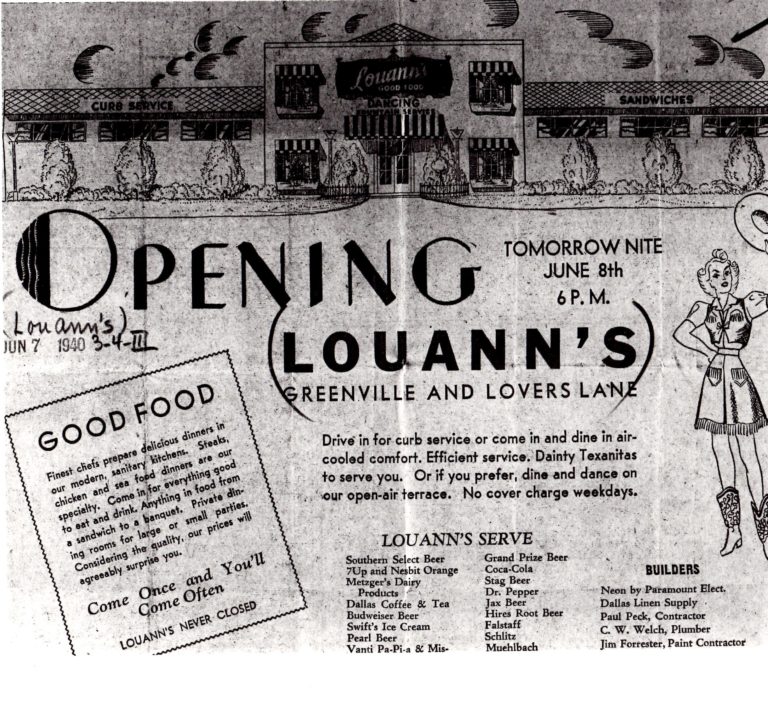
Tear sheet for ad appearing in The Dallas Journal on June 7, 1940
The second floor of the building contained the couple’s living quarters, which was a necessary convenience since the business was open 24 hours a day. The ground floor provided “inside” dining and boasted two private dining rooms, with a kitchen on the north side of the building. At the rear (east side) of Louann’s was a terrace which Ann referred to as the “porch” where patrons could dine and/or dance outside to the music of a jukebox. On Saturdays, the cover charge was 10¢ or 20¢, but during the week it was waived. The original clientele included many older couples (some with children in tow); but as time went on, Louann’s became a favorite of college and high-school aged kids.
By fall, the “drive-in” had begun its metamorphosis. Ann said that she came downstairs one morning and Lou was building a dance floor. The Daily Times Herald reported in its column Night Clubs and Bands:
“Lou Bovis is having Louann’s dine and dance spot . . . fixed up for winter. A roof is being placed over the dance floor and the area is being walled in. . . .”
And, on October 30, 1940, a large ad appeared announcing the
“Gala Opening of Louann’s Winter Lodge” with a Halloween Masquerade Dance on October 31. “Come in costume or as you are. Now for your pleasure, Louann’s gives you their permanently heated and enclosed winter lodge for dining and dancing. New floor, new atmosphere, the same excellent food and service. Same price policy. No cover charge except weekends and holidays.”
The following day, The Daily Times Herald reported:
Lou Bovis has revamped his spot out on the Richardson Road (early name for Greenville Ave, aka Richardson Pike) and has transformed Louann’s into a winter garden. The dance floor has been completely enclosed and temperature will be kept constant at 80?. Mr. Bovis says a huge fireplace has been installed and the room will have a capacity of 600 people. He opens the new room tonight with a Halloween masquerade party, but patrons without holiday costumes will be admitted. Mr. Bovis said that a new policy of the place provides for matinee dancing daily with no cover charge being levied.
On New Year’s Eve 1940, patrons enjoyed that big, warm new room with its roaring fireplace and danced to live entertainment for the first time at Louann’s. For $1.50 each, celebrants could stay all night and dance to the music of Phil Baxter and his Orchestra. Party favors and noisemakers were included. Dinners were priced at 40¢ and up.
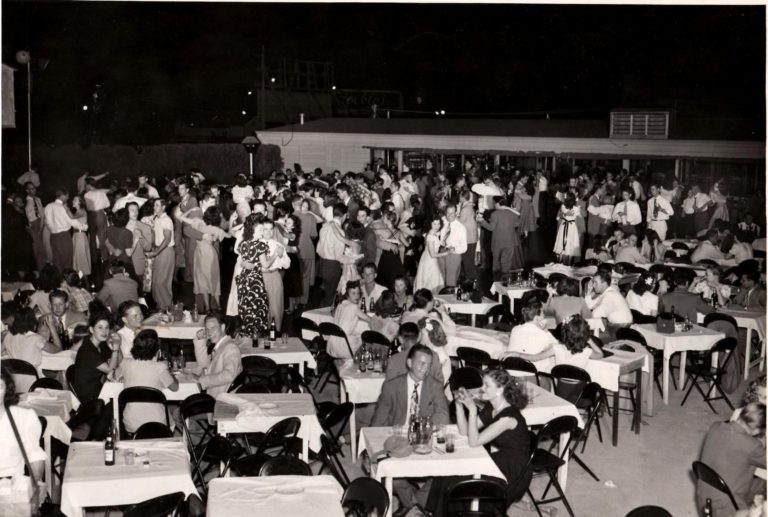
Outdoor seating and ‘Dancing Under the Stars’ at Louanns, 1950s
The following spring, Lou began constructing the new outdoor dance garden. Its completion coincided with the first anniversary of Louann’s. An ad in The Dallas Morning News showed a huge birthday cake with people dancing all around it. “Celebrating our Birthday with the Opening of a new Outdoor Garden. Saturday Nite’s The Big Night! June Seventh. Two Floors! One Covered. One Outdoors.” Louann’s now had a seating capacity of 1200.
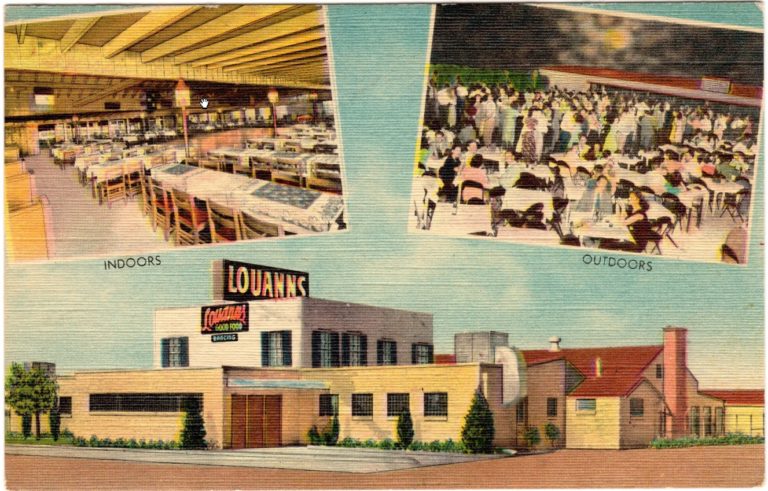
1941 postcard of the newly expanded Louann’s
On the north side of Louann’s, and accessed via Lovers Lane, Lou erected two small houses. One of them was occupied by Ann’s older brother Anton (nicknamed Marty) and his wife Celia. Celia and her brother had been very popular country-western singers and had frequently performed at Lou’s English Village in Fair Park. Celia and Marty had even been married there. In the ’40s, both worked at Louann’s until Marty re-enlisted in the Army during World War II. One evening in January 1944, while Celia was helping out at the club, her two small daughters were left alone in their frame house. It was later determined that they had been playing with matches near a gas heater and had set the house on fire, burning it to the ground along with both children. Lou had tried to rescue them but was unsuccessful. According to Ann, he suffered his first heart attack not long after the attempt.
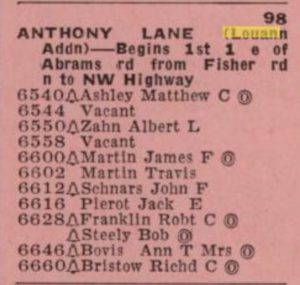
Occupants of Anthony Lane (aka Louann’s Addition), circa 1956
Just a few months earlier, as Lou and Ann had begun to prosper from the success of their nightclub, they had looked for land on which to build a home. About a mile east of Louann’s, they purchased 12 acres for a total of $8000 in October 1943. The property was bounded by Northwest Highway in the north, Fisher Road in the south, and Abrams Road in the east, with the railroad track to the west. They cleared a road from Fisher to meet with Northwest Highway, a stretch that became known as Maternity Row with the total acreage affectionately termed Pregnant Valley. Ann used to say that she would always ask Lou for more land whenever he wanted to buy her something special. So, over the years they continued to acquire adjacent property, finally amassing 26 acres.
In March 1945, Louann’s was awarded a Certificate of Good Citizenship by Southern Methodist University “In Recognition of Outstanding Service Rendered the City of Dallas and the Advancement of Progress and Learning in the Southwest.” In May 1945, the Dallas Chamber of Commerce certified that Louann’s had been elected a member and “Contributes to the upbuilding of Dallas and the Southwest.” Ann and Lou became so popular that they were even called upon by local merchants to do endorsements for their products.
On July 10, 1945, after many years together, Lou and Ann were officially married at Christ the King Catholic Church in Dallas by Rev. W. J. Nold, a close personal friend who later became the Bishop of Galveston. And on April 26, 1946, they adopted a boy, Anthony (nicknamed Tony, who had been living with them since November 1944) and a girl (who had been in their care since November 1945) who was renamed Chelle in honor of Lou’s deceased daughter from a previous marriage. The court found that Lou and Ann’s home “is a suitable home for said children, and that the petitioners are suitable parents to adopt each of said children.”
The distribution of work was now altered somewhat with Ann staying home with the children in late evenings and Lou running the club. Ann would go to the club in the mornings and take care of the day’s purchases and deliveries, and oversee the cleaning and setting up for the night. She would run errands and do the banking. Lou would leave Ann little “love notes” in the office after closing the club, balancing the register, and preparing the bank deposit for the next day. An example follows:
 “Good Morning Dear,
“Good Morning Dear,
Hope you feel better this morning. Am real tired. Feet hurt.
Yep! I still adore you even at this hour of the morning. 3:30 a.m.
Please get this to the bank early. See you later.
Love & Kisses x x x x x x x x x x x x”
On busy nights, when Lou needed Ann’s help at the club, the children would be put to sleep in the apartment upstairs which had two bedrooms, a living room, a bath, and an office. The apartment was accessed from inside the club – just up a flight of stairs near the bar, and Lou, Ann, or the head-waitress, Nonnie Gardner, would take turns checking on them. Then, when the evening was over, Lou and Ann would carry the children out to the car and drive the short trip home so that they would all awake in their own beds in the morning.
In the early years, Louann’s advertised only sparingly in local newspapers relying heavily on word of mouth. But the ads that did run were always unique and stood out from the others in size, appearance, or content. One September 1941 ad was entirely in shorthand. Other ads would be in reverse type with the background in black and the type in white. Lou and Ann also used graphics such as a moon and stars to emphasize dancing outdoors. And they advertised “Our specialty FRIED CHICKEN. We raise our own.” An ad for a Gene Krupa engagement specified that advance tickets were on sale at The Record Shop at 1304 Main. And, that Louann’s had “an acre of tables.”
Ken Foree first wrote their story entitled “On the Level” for The Dallas Morning News in March 1947, and it was picked up in part by newspapers across the country. Mail started arriving addressed to Mr. and Mrs. Louis Bovis, Dallas, Texas, c/o Maternity Row. Or, Mr. Lou Bovis, Proprietor of Housing Project “Maternity Row,” Dallas, Texas. Well-wishers and admirers from New York, Iowa, Alabama, California, and other states sent copies of their local newspapers which contained the story.

Then, in September 1947, Newsweek published its version along with two pictures – one of Lou and Ann in front of several of the houses under construction, and another on the enclosed porch of their home surrounded by a half-dozen mothers, all with babies. In the Business section of that issue, under a headline of “Housing” appeared the following article:
Children Essential

In 1942, Louis Bovis’ only daughter died of cancer. In 1944, two nieces who were living with him during the war were killed in a fire. Physicians told Bovis, a 53-year-old Dallas night-club owner, and his second wife, Ann, that they never would have children. But last week on 18 acres of land owned by Bovis 6 miles northeast of downtown Dallas, diapers by the score were hanging on the line. Lou Bovis was owner and guiding spirit of a unique housing development.
Early in 1946, when Bovis, his wife, and two adopted babies were living in one of two houses on his land, David Anderson, a war veteran, sought to rent the other house. He explained that other landlords had balked at the two Anderson children. Anderson got the house for $40 a month, and Bovis got a new idea in the bargain.
Bovis divided his property into half-acre tracts, and laid plans to build low-priced houses. No man to mince words, he christened the development Pregnant Valley and called its main street Maternity Row. Houses would rent for $50 a month at most. For potential applicants there would be just two mandatory qualifications: The husband must be a war veteran, and there must be children. Only if a couple were newly married would Bovis make an exception. If the newlyweds failed to produce, out they went.
By last week, Pregnant Valley was housing ten ex-GI families with diapers on the line behind each home. There were six frame houses renting for $40 a month and two duplexes with each apartment renting at $50. Bovis planned to build fourteen more houses plus a pool and playground when construction costs let up.
Bovis had originally expected to adopt a third child. But last week, Mrs. Bovis smilingly told reporters it wouldn’t be necessary. She is making her contribution to Maternity Row in September.
Indeed, barely a week after Lou’s 54th birthday, Ann gave birth to their first child Philip Charles Bovis on September 7, 1947. She was 37 years old. The next morning a picture of the happy 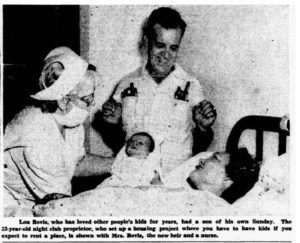 parents and their baby appeared as front page local news. Lou’s shirt pockets were crammed with cigars. The caption referred to their son as “the new heir.” Paul Crume reported
parents and their baby appeared as front page local news. Lou’s shirt pockets were crammed with cigars. The caption referred to their son as “the new heir.” Paul Crume reported
“Lou Proud Papa. A blue flag went up Sunday over Pregnant Valley, the subdivision for married GI’s established by . . . Lou Bovis, night club proprietor. . . . A blue flag in this subdivision means that a boy has been born. . . . Lou has been in the restaurant business around Dallas about as long as any man. The story of what the Bovises have done for young people with babies was first told in Ken Foree’s column. . . . It has recently been plastered over the pages of Newsweek.”
In 1949, Ann gave birth to a second son who was born premature and did not survive the day. They named him Joseph and he would have been the fourth of the five children Lou hoped for. But, in July of 1950, Ann discovered she was again pregnant. Maternity Row was officially named Anthony Lane after their adopted son Tony (today renamed Lovers Lane at its most northeastern end). All were blessed in their personal and business lives.
And the blessings and generosity continued. The Daily Times Herald in July 1949 shows a picture of a young couple described as “displaced persons” who had survived a Warsaw concentration camp. The man had been “for two years an organizer for the underground” before being arrested. Their immigration had been arranged through the National Catholic Welfare Conference. A portion of the article follows:
They now have their own home, a small apartment provided by their sponsors, Mr. and Mrs. Lou Bovis. To this young couple the most outstanding thing they have found in their new home is . . . “the freedom to go where you please and when.”
Giving two deserving youngsters a break has worked both ways for their delighted sponsors. Joseph, formerly a city dweller, easily learned to drive a tractor and farms Bovis’ 26 acres like a veteran. . . . And, Maria’s sunny nature and youthful pleasure in her new surroundings have captivated the Bovis children.
“We hope they will stay with us, of course,” observed Bovis. “But, if they want to get out on their own after a bit, we’ll help all we can.” So they’ll be able to do so, he took them downtown to open a savings account – a strange new process for two who remember only turmoil in which no institution, not even a bank, could be trusted.
Bovis studied German 35 years ago [at Columbia University in NY]. He is learning it again with Joe as his teacher. Mrs. Bovis’ parents were Polish and she spoke it as a child. She is learning the language again from Maria.
It is just one instance of the give-and-take which has made the addition of one Dallas family so successful. But it illustrates a simple maxim Bovis thinks more Americans should realize – that “these people have just as much to give us as we have to give them.”
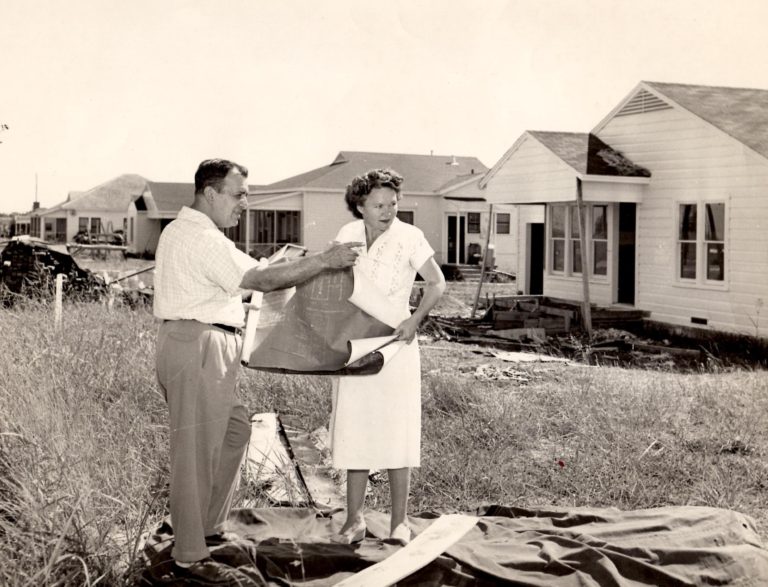
Lou and Ann Bovis laying out Maternity Row about where Lovers Lane crosses Fisher Road. They owned the property from NW Hwy to Fisher and from Abrams to the railroad tracks

Harry James and his Orchestra
As is the case for many night spots, New Year’s Eve was typically the busiest night of the year at Louann’s. Lou devised a brilliant idea for taking reservations in advance and mapping them out on a large club blueprint to ensure that no table was sold more than once. Each area of the club was labeled and each table was numbered so there would be no confusion. (This same procedure was used for any night where an unusually large number of people were expected, but it was used for every successive New Year’s Eve in Louann’s history.) At least one person in the party would come by the club and make their table selection, pay the cover charge for at least two tickets in advance, and Lou would write their names in their chosen spot on his blueprint and block out enough seats for the entire party. He would then give them their purchased tickets for New Year’s Eve with the table location clearly marked on them. When patrons arrived that evening they would just point to their place on the blueprint or show their tickets, and then be ushered to the table or head in on their own.
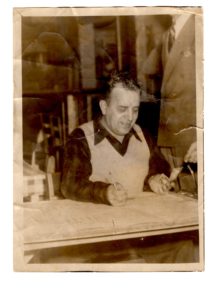
Lou Bovis with the club ‘blueprint’, assigning tables
Tent cards would be at the table to show it was “Reserved” and in whose name.
As might be expected, some patrons took advantage of the reserved cards to switch them to better tables once they arrived. But, the blueprint was always there to settle any discrepancies. In later years, in addition to the reserved card, the name of the party was written right on the tablecloth, which brought the card exchanges to a halt quickly. (Every table inside and out, reserved or not, was always covered with a tablecloth. And diners were always served with cloth napkins.)
In 1949, Lou and Ann hired their first big-name band – Woody Herman. In the twelve months that followed, Louann’s gained a reputation for drawing the biggest names in music. Gene Krupa played there to a packed house twice within 30 days. Jimmy Dorsey made his first appearance in Dallas since 1939 (at the Adolphus) when he entertained 1000 persons at Louann’s in May 1950. Other bookings included Les Brown, Ralph Flanagan, Vaughn Monroe, Ray Anthony, Stan Kenton, Artie Shaw, Skitch Henderson, Tommy Dorsey, and Woody Herman again. Fairfax Nisbet reported in her column that
“Louann’s continued its policy started in 1949 of bringing name bands, setting a pace as the only spot in town to do this on a sustained [basis]. . . . This policy will continue in 1951.”
And it did, including repeat performances by many of the above named bands along with Harry James on numerous occasions, Lawrence Welk, Clyde McCoy and his SugarBlues Band, Glenn Miller, and Les Elgart.
In the ’50s when Harry James played the club, he brought along his wife Betty Grable. Instead of a downtown hotel, they opted to stay at the residence with the Bovis family.
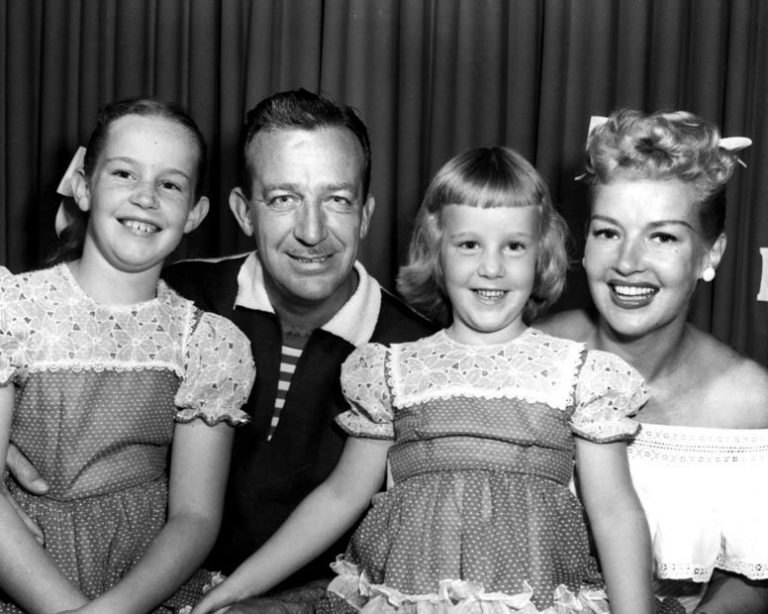
Harry James, Betty Grable with daughters Victoria and Jessica.
But, live entertainment was not the only draw – patrons just wanted to dance. For its first ten years, while most other clubs incurred the added expense of local and name bands and the advertising that went with them, Louann’s provided mostly recorded music for dancing. As a result, Lou and Ann had acquired a huge number of 78 rpm records and their “Record Bar” gained in popularity as the collection increased. The Record Bar was an actual room built between the indoor and outdoor dance floors and had windows facing each. Customers could make requests for 10¢ a song. In later years, customers would frequently ask for a particular song and have it dedicated for 25¢. A spouse or a boy or girlfriend might dedicate a love song, while members of a winning football team would request “It Only Hurts for a Little While” (or something similar) for its losing opponent. Then, the losing team would dedicate one back and the college or high school rivalry would continue long after the actual game was over.
On October 16, 1950, The Dallas Morning News reported on many interesting topics including: the State Fair Calendar for that day which was “Negro Day,” the Wake Island meeting between President Truman and General MacArthur to discuss post-war Korean policy, and Governor Dewey’s support of Ike for President in 1952. A front page column, Last 24 Hours in Dallas, briefly covered the Oklahoma-Texas football game which had taken place the day before and had broken all Fair attendance records. One downside was that a number of fans had been sold counterfeit tickets (at $100 per four) and had not been allowed into the stadium. The final announcement was the death of Lou Bovis who had died of a heart attack the day before.
The Dallas Morning News featured a picture of Lou with a headline reading “Child-Loving Louis Bovis, Owner of Night Club, Dies.” A lengthy obituary followed which summarized most of his accomplishments.
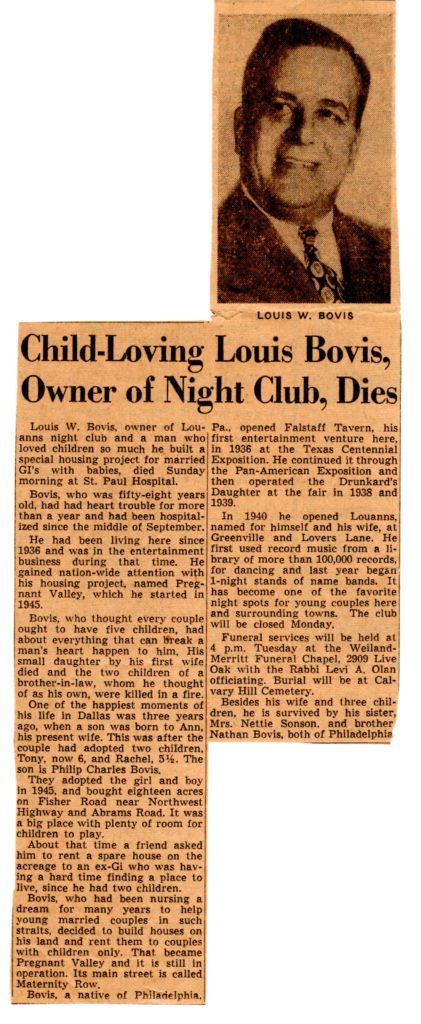
Dallas Morning News article from October 16th, 1950
The Daily Times Herald had the same picture, underneath which appeared a shorter obituary. Here is a brief excerpt:
Tuesday Rites Set for Owner of Night Club
Mr. Bovis had been ill of a heart ailment for more than a year and had been hospitalized since September. He was the owner of Louann’s Night Club which he opened here in 1940 and named after himself and his wife, Ann. He first came to Dallas in 1936 and . . . opened the English Village at the Texas Centennial Exposition. Mr. Bovis was born in Philadelphia, Pa., and was reared in New York. He was a 32nd degree Mason and a Shriner. He was a member of Congregation Shearith Israel.”
On her following birthday March 21, 1951, Ann gave birth to another son. As was Jewish custom to name offspring in honor of deceased loved-ones, this son was christened Louis William Bovis after his father. Ann now had four children to raise, all aged six or younger. In addition, she had a night club and a home to run and tenants and rental property to manage. In the years that followed, she mastered it all.
Throughout Louann’s existence, patrons brought in their own hard liquor, usually in brown paper bags. They would purchase mixers and ice at the club. In addition, Louann’s served a variety of beers, wines, and soft drinks. To stay in favor with the Liquor Control Board, Ann would police folks as they entered the club and ask for proof of age if they were bringing in alcohol and appeared to be under 21 years old. Frequently, people would have to leave a bottle at the ticket counter or return it to their car before they could gain admission. In an attempt to circumvent the rules, it was not unusual to find customers frequently going and coming from the club to the parking lot to obtain small amounts of liquor in paper cups. The bolder ones would even go back out to the parking lot and retrieve their bottle and pass it over a fence to a friend inside. Girls would try to sneak in a bottle in an oversized purse or hide it under their clothing. Ann knew all their tricks. Even so, sometimes they succeeded in getting a bottle past the door, only to later have their waitress remove the alcohol for safe keeping until the patrons were ready to leave for the evening.
Ann rarely allowed a customer to come in “stag,” that is, without a date. Her experience had been that a single man asking another fellow’s date to dance could result in an altercation. An exception was made if the single person was joining a larger party of people. Otherwise, the man would be asked to sit at the bar or on the “mezzanine” to enjoy a drink or a meal, and to watch all the action. He would not be charged admission and did not seem to mind the arrangement.
The mezzanine was actually the best location in the club for people-watching since it provided an unobstructed view of the stage and the dancers while remaining distant from the actual hustle and bustle of the crowd. The plush mezzanine – a beautifully decorated, raised area right off the main lobby – was set up with tables and soft leather chairs and banquettes. Pastel florescent lighting, installed on walls five feet from the floor, was directed toward the ceiling. A large indoor dance floor was just a few steps away, as was the bandstand. It was the place where Ann frequently seated her personal friends and other special guests: families of the band, members of the press, politicians and elected officials, Liquor Control Board and Police officers, etc. Of course, their cover charge would be waived and they were often treated to dinner. On Big Band nights, her children were also allowed to take their evening meal on the mezzanine and watch all the excitement. Usually, Ann would introduce the band leaders to the children who would, naturally, obtain autographed pictures.
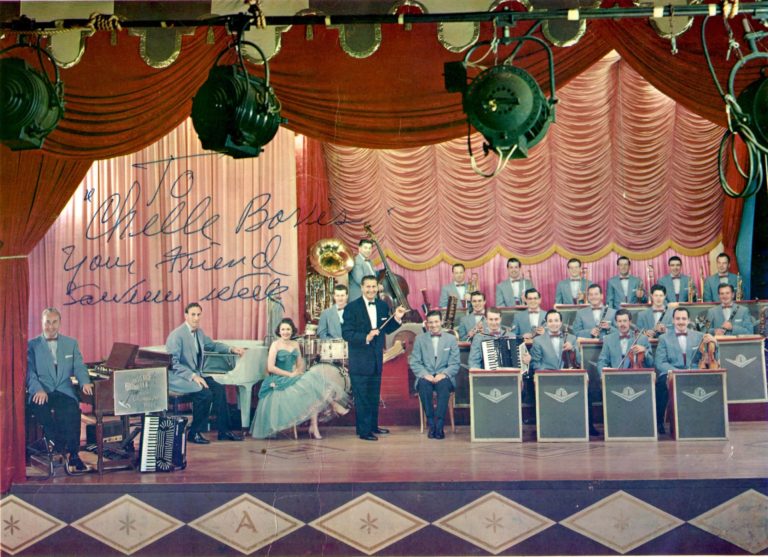
Lawrence Welk and his Orchestra
The club’s headliners were the big country acts of the time, like Ray Price. Strangely, the biggest act in Louann’s history was Lawrence Welk’s polka orchestra, which drew over six thousand people… Micheal Nesmith, excerpt from INFINITE TUESDAY: AN AUTOBIOGRAPHICAL RIFF Copyright © 2017
While there was no written dress code for Louann’s patrons, Ann did have certain expectations of her customers and somehow they knew what those were. Typically, men wore suits or coats and ties (sometimes military uniforms) and always removed their hats once inside. Women wore dresses (sometimes gowns) and heels. Of course, many a pair of high heels was left under the table when a couple got up to dance. In those days women always wore stockings, so it was not unusual to see a female patron who had danced the night away have no “feet” left in her stockings at the end of the evening.
For years the Shriners held frequent bingo parties at Louann’s on week nights and the club would be closed to regular patrons for lack of space. There was no need for music, but there was plenty of eating before the games and drinking during them. Ann’s children also enjoyed playing bingo even though they were not allowed to “win” anything. Behind the front bar and adjacent to the club’s main kitchen, was a private dining and sitting area (called the Hibernian Room) mostly used by the family. It was here that the children took their evening meals, watched TV, did their homework, or listened to the numbers called during the bingo games.
During the summers, Ann would take the kids on vacation. Frequently, it would be a road trip to Galveston where the clan would take a suite of rooms at the Jack Tar Village right across from the Gulf of Mexico. There they would stay and swim, play, and eat for a week. Since Ann loved to fish, they would often drive from Galveston to Port Aransas and stay at the antiquated Tarpon Inn and go deep-sea fishing for days on end. While the family was out of town, Ann would “loan” her grand home with its well-stocked refrigerators and library, swimming pool, sundeck, riding stables, etc. to the nuns of Ursuline Academy (which Chelle attended). They were assured total privacy and always had a blast!
Ann put all her children on the payroll once they reached an age where they could help out on weekends, however slightly. She felt it was important that they understood the value of money and how hard it was to earn. For example, during cold weather, Chelle would work in the coat room checking in men’s and women’s coats and hats. Tony would take tickets at the “door” and show people to their tables. Philip would help keep the bars stocked with cold drinks and ice. Louis would often literally get into the act by playing his trombone or baritone with the band. He loved to strut his stuff to “When the Saints Go Marching In” even though his musical instrument was almost as big as he was!
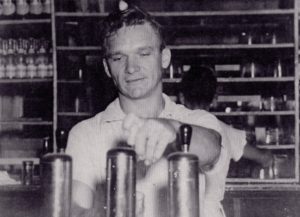
Ann’s youngest brother Charlie behind the bar.
In addition to the children, many other family members were involved. Ann’s brother Charlie (who later retired from the aerospace industry) and his wife Gloria operated their own side business within the club for many years. They were the official photographers of the patron’s snapshots. Charlie had a dark room right behind the Record Bar where he would develop the pictures. While he was doing that, Gloria would go from table to table asking customers if they wanted their handwriting analyzed or their fortune told. They were an eccentric but much-loved couple.
One of Lou’s nephews Jule later took over the job as photographer. Ann was paying for his college education at the University of North Texas, and he worked at the club to earn spending money. Jule ultimately became a master photographer and today owns his own studio – Bovis Photography.
Ann’s sister Stella and her husband Pete, who had previously owned a pizzeria in Chicago, came to Dallas to run the pizza kitchen that Ann had added onto the north side of the building in the ’50s. Ann gave them one of her rental houses to live in and it was their home for the rest of their lives.
The pizza kitchen was open days and nights and sold many a pizza “to go.” An almost daily customer was Lee Trevino who worked at Hardy’s driving range on the north side of Lovers Lane, an area known today as Old Town. (While he later went on to golfing fame in the PGA and the Senior PGA, in those days Lee barely had two nickels to rub together.) Pizza and burgers made in this kitchen were also purchased by club patrons since they naturally got hungry from all their dancing. Another favorite food item was the brisket which Ann cooked in the brick barbecue pits she built at the rear of the club.
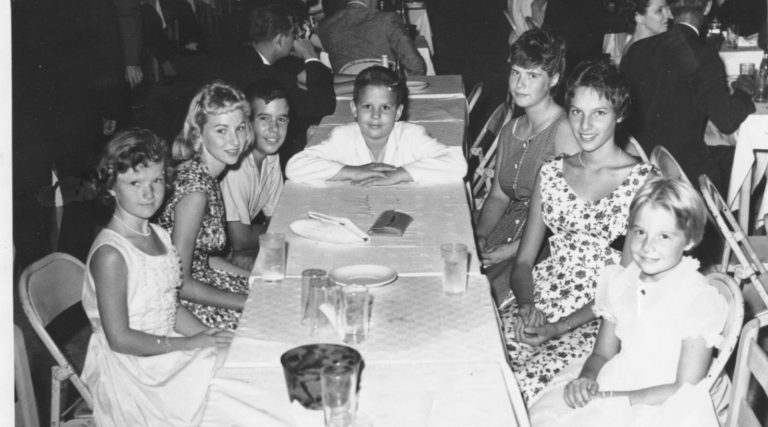
Philip at the head of the table, Tony to his left, Chelle in middle on right, with classmates and cousins enjoying Clyde McCoy who autographed the back of this picture in the ’50s
It was also in the 1950s that a promoter named Tony Davis approached Ann about using Louann’s on Sunday afternoons for dance matinees for black patrons. In addition to Sunday being her typical day of rest, Ann was at first apprehensive that she might lose some of her existing clientele, even though the two groups would not be in attendance at the same time. After some consideration, she went forward with the deal; and, as time went on, her concerns proved unwarranted. Mr. Davis role was to hire the bands, do the advertising, and sell the admission tickets (proceeds which he kept). Ann provided the club (cleaned and set up after a Saturday night), the waitresses, and the bars (revenues which she kept). To accommodate some drinking changes that Mr. Davis suggested, she special ordered quantities of malt liquor and also milk, which his patrons drank with their bourbon. The matinees were a huge success. The patrons were always beautifully behaved and elegantly dressed especially during an occasional debutante party or wedding reception.
Louann’s was famous for its dance floors and by the ’50s there were three: two inside and one outside with a total seating capacity in excess of 2000. The original indoor dance area that Lou had built in 1940 now had pennants from all the colleges hanging from the rafters, and of course was air-conditioned. The wooden floor had been re-surfaced but otherwise had changed little. The original outdoor dance floor that Lou had built in 1941 had been completely redone and the area was enlarged and totally enclosed. Additional restrooms and bars had been added. But, Ann’s pride and joy was the spacious outdoor “garden” with its beautiful terrazzo dance floor. It was fully landscaped and contained several marble statues. True romantics favored dancing in the garden even when it was raining or was cold outside. They would go up to the Record Bar and ask for the music to be turned on out there, and the attendant would just flip a couple of switches. Each of the three dance areas comfortably seated about 750 people and could be completely separated from each other via sliding doors. So on any given night there could be three different parties going on at the club, as was often the case in the mild-weather months.
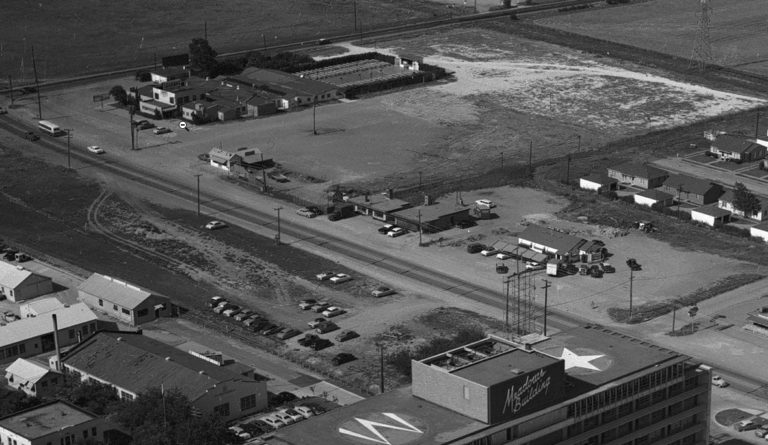
1950s view of Louanns. Lovers Lane is at the top of the page heading East. Greenville is at the bottom heading South. Courtesy, Squire Haskins Photography Collection, Special Collections, UTA Libraries.
For about half the year, the garden was used for the general public while a wedding reception or some other function took place in the center room. (On one occasion, Highland Park High School seniors had a chaperoned, all-night slumber party in this very room.) Or the garden and the air-conditioned center area might be used for the public while a high school reunion or other private party took place in the main “front” area. Or the front area might be closed and only the garden and the center room used. There was a great deal of flexibility. In the colder months, the center area and/or the front room were used, and there was always a fire roaring in the huge fireplace.
To facilitate three different groups at the same time was no small feat – each needed their own source of music, their own bar, and their own admission booth. To accomplish this, Ann had built a second entrance – the “garden” entrance – 150 feet or more to the east of the main one. Once in the garden lobby area (with its own coatroom), people would be directed through one of two arches. If they were with a private party, they would go to the left into the center room. If they were public customers, they would pay a cover charge and step to the right onto the huge outdoor dance area. There, tables were set up on three sides of the terrazzo floor with a covered bandstand adjacent to the building. A vast bar with cash registers in two separate areas was inside. The bar bins had to be constantly restocked to keep up with the sales of ice and mixers.
In 1960 the main “front” entrance was re-positioned and the ’50s front doors, lobby and coatroom were eliminated and replaced with landscaping and room for additional parking. The intent was to modernize the entire exterior. The new entrance had a huge, metallic overhang so that if people were waiting to get in, they could stay out of the elements. Just inside the front door was the relocated coatroom. At the far end of the lobby was the original long bar at which usually sat the “regulars” who were content with drinking beer and watching the constant parade of customers coming and going. Also, in the front lobby was a glass-enclosed showcase in which hung the jewelry which patrons had lost at the club. Frequently a missing earring would be claimed by just bringing in the matching one.
Behind the front bar, was a large kitchen which served tens of thousands of dinners over the years, including 1500 steak dinners for the IRS one Christmas. Adjacent to the bar was the ticket counter. After customers paid the cover charge, they would walk through the mezzanine and down some steps to the main dance floor, surrounded by long rows of tables. A large stage was at the south end of the dance floor and the great fireplace was at the north end. The Record Bar was located between the main and center dance areas.
All three areas could accommodate individual music sources. The elaborate sound system was versatile enough to allow for each room’s speakers to broadcast a different band and/or music from the Record Bar. So, there could be recorded music in one room, a mariachi band playing for a Mexican wedding party in another, a rock and roll group in the third or any combination of music imaginable.
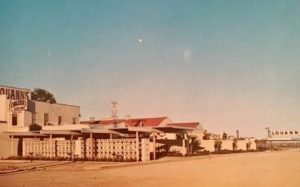
1960 Louann’s postcard showing both the front entrance and the Garden Room entrance
The ’50s had ushered in Rock and Roll but that style of music became the norm for Louann’s in the ’60s. In his column Dallas After Dark, Tony Zoppi reported:
Louanns Changes with the Times
Things are booming at Louanns. Ann Bovis, who has operated the popular late spot on Greenville Ave. for the last 20 years, can credit her success to her ability to accept trends in entertainment and adjust to constant change.
When big bands were in swing, nobody booked more names than Mrs. Bovis. When outdoor dancing became the rage, she constructed the most beautiful outdoor floor in town. Now there is a demand for rock ‘n’ roll, and the Watusi has replaced the waltz. It took a bit of doing, but Ann Bovis accepted the inevitable. For the past two years, the sounds here have changed from hot to cool. . . .
Another change was that customers now dressed more casually. Female patrons frequently wore mini-shirts and flat-soled shoes (as was the fashion), and men dressed more comfortably in shirt sleeves. Still, no one in shorts or jeans was allowed admission.
An important personal change for Ann was that her own children were now teen-agers. Never really enjoying the “noise” produced by Rock and Roll bands, she happily allowed them to audition the talent that would be hired at the club, feeling they were in a better position to know what the customers would appreciate. Saying “this is probably 1/100 of the R&B and Rock and Roll groups that played Louanns,” her son Louis provided the following list of artists who were popular in the ’50s and ’60s:
Johnny G & The G Men
Trini and Jesse Lopez
The Floyd Dakil Four
Kirby and Mike St. Romain
Scotty McKay
Roosevelt Wardell
The Esquires
Southwest FOB
Jon and Robin & The In Crowd
The Jackals
The Chessmen
The Bricks
U.S. Mail Bag
The Novas
The Mystics
Kenny & The Casuals
Ray Sharpe
The Bridge
Frontier Shepard
Mouse & The Traps
Kenny Rogers & The Five Americans
Freddy King
NTSU Lab Band
Little Willie John
The Chapparals
Aretha Franklin
Red Fox
Ike and Tina Turner
The Drifters
Jimmy Reed
The Impressions
Bobby Bland
The Turtles
Jeff Beck & Rod Stewart
Jimmy Smith
Paul Revere & The Raiders
Mitch Ryder & The Detroit Wheels
Rocky and Dusty Hill (Lady Wylde and the Warlocks, later ZZ Top)
Wooden Nickel
The Yardbirds
Mario Daboub & The Nightcaps
The Marksmen
Joe Turner
Johnny Green & The Green Men (dyed green hair)
The Ray Charles Orchestra
Nino Temple and April Stevens
Boz Scaggs
The Fugitives
In the ’60s, the children were an integral part of the weekend operations of the club. They ran the Record Bar, sold admission tickets, worked behind the bars, in one of the kitchens or wherever Ann needed help. Philip engineered the strobe lighting and other special effects which delighted the dancers.
Occasionally the children would invite their Ursuline, Jesuit, or Christ the King classmates to parties there. And, frequently those schools would use Louann’s free for a fund-raising event. Ann also hosted the schools’ “Annual Signing” bashes at the end of the academic year when all the students came together to sign each other’s yearbooks. In these ways, Ann could keep abreast of her children’s activities and friends.
One unusual use of Louann’s on Sundays in the late ’60s was the popular “flea market,” where vendors would set up tables to sell their wares. Individuals would pay Ann a flat fee for the table(s), and all the proceeds of their sales would be theirs. These events took place several Sundays a month and the club would always be packed.
On Sunday, February 1, 1970, the Dallas Times Herald reported the following:
 New Beat at Louann’s as Ann Bovis Era Ends
New Beat at Louann’s as Ann Bovis Era Ends
“Ralph Marterie was the last swing band we booked. It was in 1958. And, out of a capacity of 2000, only 248 people attended.”
The person speaking was Ann Bovis, owner and manager of Louann’s, which for three decades has been the heart of the Dallas night scene for many people. . . . Reminiscing about Louann’s 30-year reign of popular night clubs in Dallas, Mrs. Bovis continued, “During the ‘big band’ era we had all the big ones – Harry James, Glenn Miller and the Modernaires, Gene Krupa, Stan Kenton, Woody Herman and his seven-piece combo, Tex Beneke, and many others.
“On Jan. 2, 1956, for one performance,” Mrs. Bovis smiled, “we brought in Lawrence Welk and his 21-piece band and two vocalists for $2,000. They played from 8:30 p.m. to 12:30 a.m. and the place was packed. . . . Can you imagine what it would cost to book Lawrence Welk now?” . . .
“Ever since my husband and I opened Louann’s,” Mrs. Bovis added with pride, “we’ve changed it about every seven years. The last time was in 1960, and now a new crop of youngsters are looking for a place to go. So, I’m happy to be able to change the club along with them.”
However, Mrs. Bovis won’t be taking an active role in the club’s new phase, saying with an eye to the future, “I’m going to go live on my ranch and take it easy for a while.”
And so it was that in 1970, as her 60th birthday approached, Ann retired and moved to the peace of her country ranch. She retained ownership of the Louann’s land through a long-term lease to Lincoln Property Corporation which had recently begun developing “Old Town” on the north side of Lovers Lane. The buildings were sold to Larry Lavine, a former night club competitor; but the landmark building suffered a devastating fire in April Fool’s Day 1971. In the decades that followed, the property became home to a variety of tenants including the once highest grossing club for liquor sales in Dallas (Confetti’s), male and female strip joints, liquor stores, restaurants and bars. Over the years it became a true eyesore until, in 2000, the buildings were leveled to make way for the new Central Market. Today the upscale supermarket stands in almost the same spot where Louann’s had been in its heyday.
But the memories of Louann’s were far from gone. In February 1977, the cover of D Magazine heralded
“Dancing’s Back in Town! Remember Louann’s, The Jitterbug, Harry James, and The Junior Prom?”
Touch-dancing had come back into vogue, and the article inside contained an extensive interview with Ann.
Following are some of her memories:
Remembering Louann’s
In 1939, the twist was something that happened to a pretzel or a lemon peel. . . . And that was the year that Lou and Ann Bovis opened an unpretentious drive-in restaurant at an out-of-the way North Dallas intersection. The intersection, Greenville at Lovers Lane, was later to become the southeast corner of the civilized world. . . . Louann’s was to serve for 30 years as the hub of the Dallas dancing scene. . . .
“. . . we had an elaborate 110 speaker sound system installed by RCA for $10,000. They were so excited by such a big sale that they threw in a free TV set, but it wasn’t much good because there was no TV station here until eight years later. By that time the set wore out from people fiddling with it.”
Ann Bovis remembers fondly the troops of young couples who made Louann’s their courting spot. “Mothers and fathers would call here all the time and ask me to go out and look to see if their son or daughter was here, without it being obvious. . . . A lot of the 16-year old girls couldn’t even get permission to date unless the boy agreed to take them to Louann’s.”
Ann Bovis’ recollections of Louann’s span 30 years of touch dancing in Dallas. . . “The best behaved group of all,” Ann says, “was the Aggies of Texas A&M. . . .They were regular gentlemen.
“Highland Park High School kids had a graduation party there in the early Sixties and tore the place up. Fortunately, the principal called a special assembly in the school auditorium and told them that they couldn’t graduate until they paid for fixing Louann’s back like it was.”
But the roughest kids, Ann recalls, were the Lakewood Rats. No second place. “This was a gang of kids during the Forties and Fifties from Woodrow Wilson High School. It finally got so bad that Lou had to bar them. One of them is a millionaire now, and when they had the Woodrow Wilson homecoming in 1969, his cronies had an elaborate certificate printed up for me to sign giving him special permission to come in for just that one night.
The biggest spenders, according to Ann, were the students from Oklahoma University. But only if they beat Texas. “They would park their cars out here and take buses to the Cotton Bowl. If they won, we were in for the biggest night of the year.”
Other remembrances include:
The most popular songs. “I would say that the all-time favorites were ‘Perfidia,’ ‘Chantanooga Choo-Choo,’ ‘The Beer Barrel Polka,’ and ‘Celery Stalks at Midnight’.”
The most unpopular song. Goodnight Sweetheart. “This was the song that Lou played every night . . . to let people know it was closing time. It finally wore out and we had to switch to ‘Dream’.”
The most popular dance. “The one that people had the most fun with was the Bunny Hop that Ralph Flanagan would play when he was in. They’d line up and dance all the way out into the garden, past the liquor store and back in the front door.”
The best decision. “Erik Jonsson had a big party out here for the Texas Instruments people in the early Fifties. And when he showed off one of those new-fangled transistor radios, I decided to buy some stock in the company. . . .”
In 1988, Kirk Dooley wrote his book, Hidden Dallas, and had this to say:
Thousands of Greenville Avenue funseekers frequent the area every night, but few people realize what brought about that pendulum swing making Greenville Avenue the top attraction in the city. Actually it was the effort of two people, Lou and Ann Bovis, back before WWII.
The Bovises had a popular nightclub located practically out in the country . . . which featured dancing to the Big Band sound – the most popular music of postwar America. . . .Louann’s personified the best face Dallas had to offer in the ’50s. Where there are now hundreds of choices for dancing in Dallas, back then there was, in many people’s opinion, just one. Louann’s.
Although it is amazing to think that one club could create a path that hundreds of clubs, millions of customers and billions of dollars have followed, such is the case with Louann’s. There wasn’t anything like Louann’s during the war years, or post war years, which survived the end of the Big Band Era, and there has never been anything like it in Dallas since. The legacy Louann’s left behind is the nightlife which followed its lead along thriving Greenville Avenue each night, every year since.
On May 14, 1993, Ann Bovis died quite suddenly of a cerebral hemorrhage (following a stroke) in a hospital north of her ranch with her four children at her bedside. But, still the legacy continued. Unaware of Ann’s death the week before, the East Dallas/Lakewood Advocate published this article in their The Way We Were column:
Saturday Night Fever at Louann’s
As neighborhood seniors prepare for graduation, plan parties and sign yearbooks reflecting high school memories, a graduate of Woodrow Wilson High School recalls the favorite hangout for the class of ’44.
“Just about everyone from Woodrow went to Louann’s to dance,” says Ernest “Carl” Brandt, a resident of East Dallas since 1927. “For 50 cents, we could get in and dance until 1a.m. That was on Saturday nights, of course.
“There were two huge dance floors – one inside and one outside. We danced to records mostly, and for 10 cents, we could make a special request at the window of the record room. There was a lady there who was in charge of the record library that contained hundreds of 78 rpm records. We could go up to the window, yell to her what song we wanted, and give her a dime to play the selection. . . .”
Brandt says some of the most popular songs of the time were Glenn Miller’s “In the Mood,” “Tuxedo Junction,” and “Pennsylvania Six Five Thousand,” Artie Shaw’s “Begin the Beguine,” Woody Herman’s “Woodchopper’s Ball,” and Tommy Dorsey’s “Boogie Woogie.”
“Occasionally, big name bands would perform in person. I saw Gene Krupa and Tommy Dorsey play there,” he says. . . .
Carl Brandt was what you might term a “rabid fan” of the club. He was also one of the infamous “Lakewood Rats,” a graduate of Woodrow Wilson, and a self-proclaimed “Louann’s grad.” He wrote Ann after she retired and tried to visit her at her ranch to discuss old times. He would mail her pictures taken at the club and reminisce about “those WONDERFUL YEARS so long ago. Every time we pass the Lovers Lane/Greenville intersection, I mention something like ‘Well, there’s where it all took place’.”
In June 1993, Bob St. John dedicated his entire column to the memory of Louann’s. A portion follows:
Ah, to be young and at Louanns
Like so many Dallasites, I have fond memories of those youthful summer nights when we’d sit and talk and dance as if time would never end in that gigantic outside garden area at Louanns. Oh, the club was air-conditioned inside, but it never seemed that hot out there in those days. . . .
Local schools and businesses would have parties there and, if entertainment wasn’t booked, you could dance to the music of about 10,000 records, sometimes played by a young DJ named Ron Chapman.
Louanns left a nice afterglow for so many of us and the memories came back when I heard that Ann, 83, had died recently. There was no fanfare and little notice of her passing, and she probably would have preferred it that way. She sought no publicity for herself but only for the club she opened with her husband, Lou, in 1939.
Some months later, KERA began encouraging people to come forth with their memories and pictures of Dallas from the 1930s to the 1960s. The result was a 60-minute public television special entitled “Remember When,” produced by KERA in 1994. One segment of the film featured night life during those years. Emphasizing that Dallas was segregated in the ’30s and ’40s, it opened with a piece on the Rose Room (formerly the Empire Room) which was a favorite club for African Americans. From the Rose Room on Hall Street, the film moved up north to Louann’s. As various Louann’s memorabilia flashed across the screen, Ray Wylie Hubbard narrated: “Another popular place in Dallas started as a drive-in soda fountain in a parking lot big enough for a plane to land on Lovers and Greenville in 1940. The owners were a couple named Lou and Ann.”
Interviews with former customers attested to the fun they had there as high school and college kids. They talked about drinking cokes and dancing the night away on the indoor and outdoor dance floors. Any woman who was named “Louann” could get in free and people could get in free on their birthdays
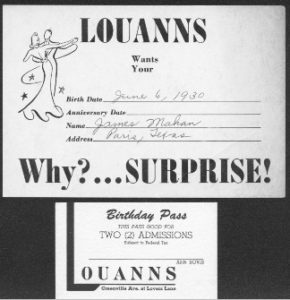
Customers could complete the card at the top and get the pass at the bottom
One former female patron described the experience as follows:
“It was a rite of passage, a part of growing up, and just somewhere you should be. It was almost like it was an important date if you went to Louann’s. I do remember the feelings when that music came on for the last dance with your boyfriend and the evening would be over and you didn’t really want it to ever be over.” KERA wound the segment down while playing “Goodnight Sweetheart.”
No other night clubs were featured.
As recently as February 1998, Louann’s received mention in Steve Blow’s column in The Dallas Morning News under the headline “Dallas in 1952: Now, that was the good life.” Tony Zoppi, who wrote a column called Dallas After Dark (in 1952 and for the next 13 years), was reminiscing to Steve about various night clubs and said:
“Here’s a popular one – Louann’s. It was on Greenville Avenue way out in the boondocks, surrounded by nothing but cotton patches.”
Steve’s note:
“It was ‘way out’ at Greenville and Lovers Lane.”
Today the legacy continues in more subtle forms. One of them is at the Lovers Lane Dart rail station where there is a mural which memorializes Louann’s and other bygone spots along the Lane.
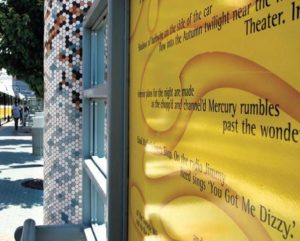
Lovers Lane DART Station Mural

Another view – Lovers Lane DART Station Mural
As times have changed many old Dallas landmarks have disappeared which makes their memories all the more precious to those whose lives intersected with them. New generations have different wants and needs; but, many old-timers and baby-boomers will always remember Louann’s as “the place” where they had the times of their lives.
Dream when you’re feeling blue
Dream, that’s the thing to do
Just watch the smoke rings rise in the air
You’ll find your share of memories there So, dream when the day is thru
Dream and they might come true
Things never are as bad as they seem
So dream, dream, dream
“Dream”, closing song from 1950 until 1970, replacing “Goodnight Sweetheart”
Thanks for the memories, Lou and Ann.
Dream on…

Ann and Lou bid you Adieu!
You can add comments at the bottom of this page – and be sure to add your email in the Newsletter Registration link.
Come see us on Facebook at: https://www.facebook.com/groups/MemoriesofDallas/
We also have a new sister page for Football and Cheer-leading in Texas at https://www.facebook.com/groups/texasfootball
If you would like to donate a few dollars to keep articles like this coming, please Click Here! We are a fully approved 501c3 non-profit. Your donations are deductible, see your CPA.
All copyrighted materials included within Memories Incorporated dba Memories of Dallas are in accordance with Title 17 U.S.C. Section 107 related to Copyright and “Fair Use” for Non-Profit educational institutions, which permits Memories Incorporated to utilize copyrighted materials to further scholarship, education, and inform the public. Memories Incorporated makes every effort to conform to the principles of fair use and to comply with copyright law.
You can also share this story on your Facebook page or Twitter, click on the links below.
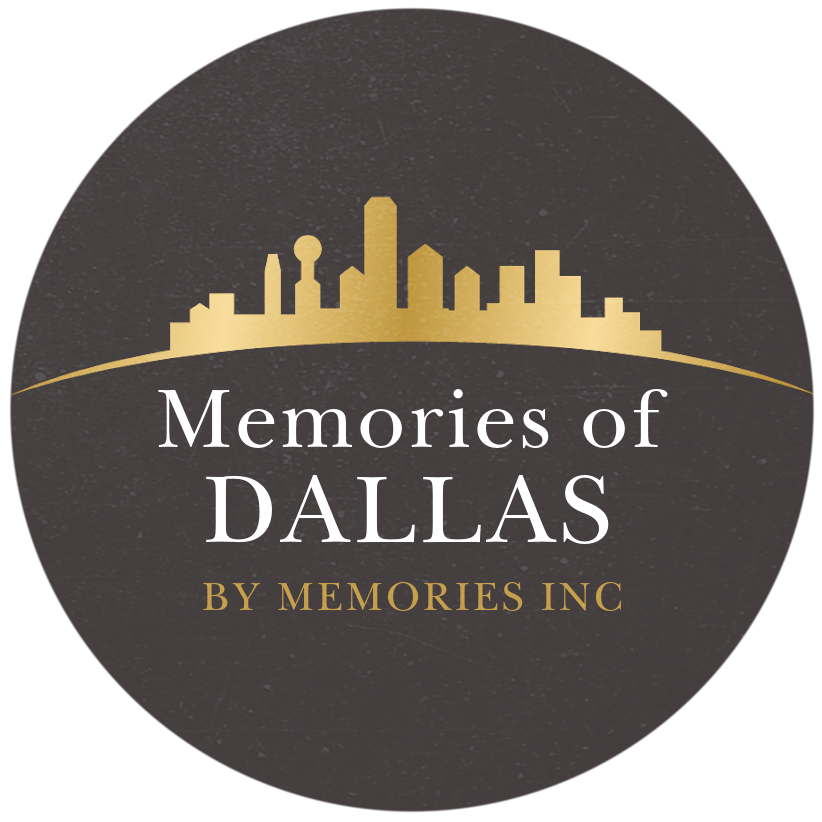

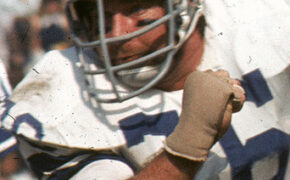


jay vinton
This was very interesting. I like so many other young Dallas teens in a band played at Lou Ann’s. It was the coming up place for local bands. One evening my small highschool band, “The Minutemen” from Carrollton / Farmers Branch played with Mouse and the Traps. We were thrilled.
At the end of the evening, at load out, myself and Bugs Henderson put a Dual Showman speaker cabinet through the front plate glass window by accident. Mrs. Bovis was not pleased. It was late, 2:30ish or so and she would let no one leave until the emergency glass man came and reinstalled the glass. Mouse and the Traps were docked half their evening earnings, and my band docked the entire evening. Both of us must have been Pariahs to the other band members for about a week. It was one of those places that if you played it, you had arrived.
pheckmann
What a cool memory! Strange the things that seemed so bad in the moment are cherished today. Thanks for that Jay.
Be sure to check out Parts 1, 2 and 3. Kirby St. Romain, Jack Mitchell (Styx) and several others all contributed
Chelle Bovis Banks
My brother, Lou, was great pals with Bugs long after the club closed. Too bad you weren’t loading thru the side gate! No glass there.
Larry Dollgener
The waitress serving the pilot was my aunt Helen Dollgener.
meminc
very cool!
Alfred Brown
My band “Daniel” played the rebuilt Lou Ann’s (after the fire) many times. It was a very large high ceiling room with a large open stage. It was often packed and a great venue to play. We had played the Studio Club often and our agents probably knew Larry Lavine. Later I played with the bass player that had been with the Styx when Lou Ann’s burned down. Larry Tagg, who is in the picture you posted of the Styx, later played with Tod Rundgren.
Pat Doran
My older brother Mike played with Louis and Joe Haggar Eddie Maher in a band, the name escapes me. I personally played in a band named Felix for two years *(1971-1973).